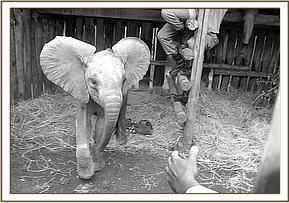During a surveillance recce searching in Tsavo East National Park area for one of Tsavo’s enormous Tuskers on the 16th June 2010, Robert Carr-Hartley came across a majestic Bull with perfectly symmetrical tusks that reached to the ground, a rare spectacle today and the epitome of awesome power and beauty
During a surveillance recce searching in Tsavo East National Park area for one of Tsavo’s enormous Tuskers on the 16th June 2010, Robert Carr-Hartley came across a majestic Bull with perfectly symmetrical tusks that reached to the ground, a rare spectacle today and the epitome of awesome power and beauty. The following day on patrol the mobile veterinary unit came across the same bull together with a herd of handsome bulls. He was amazed to find so many handsome bulls all together in one large grouping, with no female herds anywhere in sight, and even more surprised to spot amongst them, looking miniscule, a tiny yearling calf, quite obviously an orphan whom they were protecting from predation.
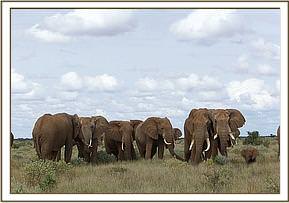
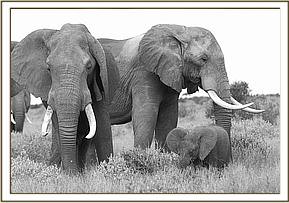

The Trust’s Mobile Veterinary Unit monitored the calf and its unique Protectors for the rest of the day, hoping that perhaps the mother might appear to reclaim her baby, for without access to milk, the calf had no chance of survival and milk was the only commodity this spectacular herd of males could not produce. The baby in their midst looked relaxed amongst them, but was already beginning to show signs of milk deprivation, its cheek bones becoming prominent.
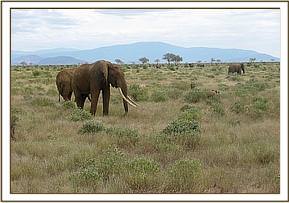
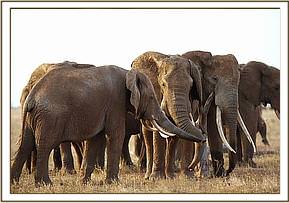
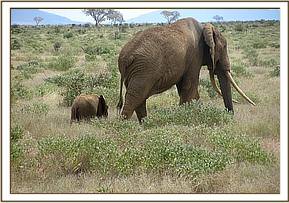

By late afternoon, there was still no sign of any female elephant herds within range of the bulls, and the baby elephant was becoming visibly weaker. Obviously, the survival of this calf rested upon being able to separate it from the bulls and hand-rear it as an orphan – no easy task when the Bull Herd had some obviously very high ranking males in its midst, for high ranking Bull Elephants don’t take kindly to being “messed around”! Under such circumstances, only experience and an in-depth knowledge of elephant behaviour counts. A rescue of this nature would not be for the feint-hearted!
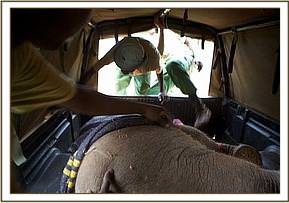

Meanwhile about six of the most experienced Elephant Keepers from the Trust’s Voi Rehabilitation Centre were brought in, the fact that an Elephant Rescue could be imminent having been reported to the Kenyan Wildlife Service. Time was now of the essence. The Veterinary Unit vehicle carrying the Keepers drove in tandem with Robert Carr-Hartley's landrover and together they drove determindly into their midst. Taken entirely by surprise, and not accustomed to such effrontery, they took to their heels, leaving just two or three around the calf, who had been left behind not able to keep pace with the fleeing adults. Ignoring the threats of the baby’s remaining Protectors they managed to separate the calf, and steer it towards the Pickup carrying the Keepers. The Protectors lost their nerve at the last minute and decided that discretion was the better part of valour, leaving the yearling calf to its fate. Instantly the Keepers leapt from the Pick-up carrying them, and threw a blanket over the calfs head and eyes as they moved in to overpower it and grapple it to the ground. The baby was approximately a year or just over, and not as strong as he should be were he well fed. Soon, he was held on the ground, and his legs were bound with special strapping before rolling him over onto the rescue tarpaulin and heaving him up onto a mattress in the back of a Pickup vehicle to be driven to the Voi Stockades. Overnight he was in with Kenia and little Kimana, adjacent to the other 13 orphans currently in the process of rehabilitation at the Voi unit’s base. Kenia is a very gentle and caring ex Nursery Matriarch, and Kimana the smallest elephant at the Voi Stockades, although not the youngest, who adores her and suckles her ears constantly. The newcomer was careful to squeeze himself between the two, and when they took their milk, he also decided to do the same, as long as he was in the middle and as such not exposed to a human!

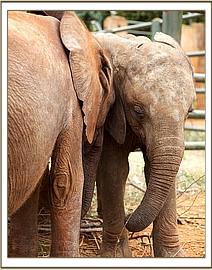
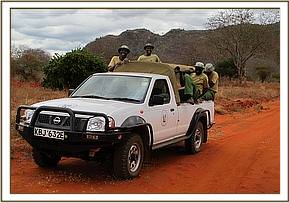
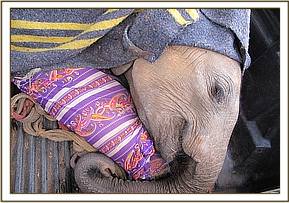
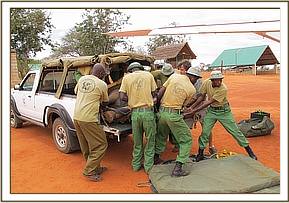
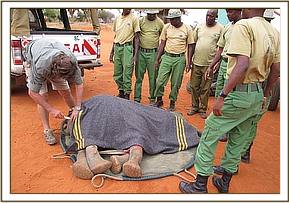
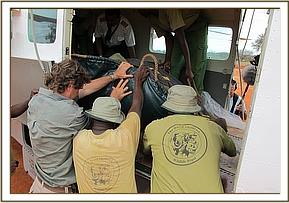

The earliest the Caravan Rescue plane in Nairobi was available to come and lift the elephant from Voi to Nairobi on the 18th June 2010 was 2.30 p.m, so Kenia and Kimana had to remain in the Stockade with him until the plane had landed. At that point the Keepers again had to overpower the new baby, bind his legs again, roll him onto the tarpaulin and again lay him in the back of the Pickup on a mattress for the drive to the Voi Park airfield, a process watched quietly by Kenia and Kimana, despite the baby’s distress calls for help. That Kenia and Kimana did not react or threaten the Keepers in any way was a testimony to the trust they have in their human family, for normally, hearing those cries, an elephant would react aggressively. Perhaps they remembered being rescued the same way when they, themselves, were first orphaned. Kenia came to the Pick-up vehicle, and touched the recumbent baby gently, as though to reassure him before he was driven away. Their mission now accomplished, she and Kimana were happy to be able to be ushered out to join their 13 other orphaned friends, no doubt fully understanding exactly where the Newcomer would be heading. When he returns back home as a healthy baby who also trusts and loves his human replacement family, those two elephants from the Voi unit will undoubtedly remember him, “for elephants never forget” and he will be welcomed and lovingly embraced, as is every new elephant that joins our family of orphaned elephants, granted by the Grace of God a second chance of life, saved from certain death if not found when orphaned below 3 years of age. Few are as fortunate as little Kandecha. But, for Robert Carr-Hartley’s interest in that magnificent Bull, he would never have been found, and would have ended up as just another tragic pile of baby elephant bones in the midst of Tsavo East National Park.
